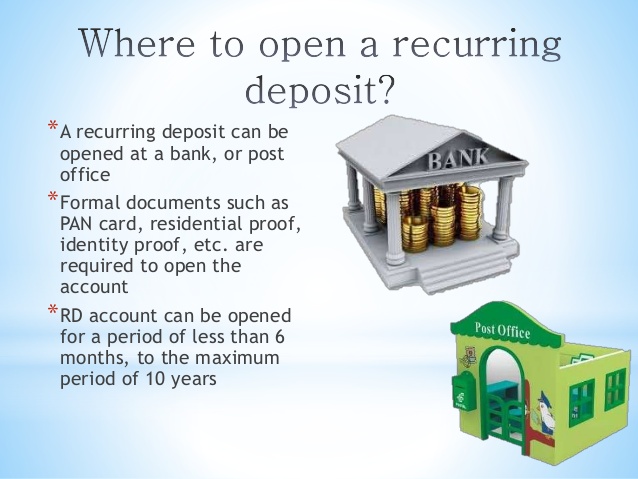Recurring Deposit
Recurring Deposit, or more commonly known as RD, is a financial investment option that works like an FD but provides fairly high flexibility. By recurring, it means something that occurs repeatedly over a course of time. Thus, investing in an RD means investors can opt to invest in instalments rather than depositing a lump sum amount. Recurring Deposit (RD) is a special kind of Term Deposit that allows customer to deposit a fix amount every month in RD account and earn interest at a fix rate. RD is a systematic savings plan that offers guaranteed returns.
A recurring deposit is a special kind of term deposit offered by banks which help people with regular incomes to deposit a fixed amount every month into their recurring deposit account and earn interest at the rate applicable to fixed deposits.[1] It is similar to making fixed deposits of a certain amount in monthly installments. This deposit matures on a specific date in the future along with all the deposits made every month. Recurring deposit schemes allow customers an opportunity to build up their savings through regular monthly deposits of a fixed sum over a fixed period of time. The minimum period of a recurring deposit is six months and the maximum is ten years.[2]
The recurring deposit can be funded by standing instructions which are the instructions by the customer to the bank to withdraw a certain sum of money from his/her savings/current account and credit to the recurring deposit account.

When the recurring deposit account is opened, the maturity value is indicated to the customer assuming that the monthly installments will be paid regularly on due dates. If any installment is delayed, the interest payable in the account will be reduced and will not be sufficient to reach the maturity value. Therefore, the difference in interest will be deducted from the maturity value as a penalty. The rate of penalty will be fixed upfront. Interest is compounded on quarterly basis in recurring deposits.
One can avail loans against the collateral of a recurring deposit up to 80 to 90% of the deposit value.[1]
The rate of interest offered is similar to that of fixed deposits.[1]
The formula to calculate the interest is given as under: where I is the interest, n is time in months and r is rate of interest per annum and P is the monthly deposit.[3]
Recurring Deposit Calculator
The formula to calculate the maturity amount is as follows:Total sum deposited+Interest on it .
Taxation[edit]
Tax deducted at source (TDS) is applicable on recurring deposits. If interest earned on recurring deposits exceeds Rs. 40,000 a year, TDS at the rate of 10% would be deducted by the bank. Income tax is to be paid on interest earned from a Recurring Deposit at the rate of tax slab of the Recurring Deposit holder. Investors with no taxable income will have to submit form 15G to avoid TDS on both recurring deposits and fixed deposits. However, for investors who are senior citizens (above the age of 60) you will have to file form 15H to avoid TDS on both RD and FD. [4]
Recurring Deposit Interest
References[edit]

- ^ abc'From Post Office RD, Bank RD to Debt MF SIP, find out your option for risk-free recurring deposits'. 13 June 2019. Retrieved 23 June 2019.
- ^Vijayaragavan Iyengar (2009). Introduction to Banking. Excel Books India. pp. 313–. ISBN978-81-7446-569-6.
- ^M.L. Aggarwal. APC Understanding ICSE Mathematics - Class 10 - Avichal Publishing Company. Avichal Publishing Company. pp. 58–. ISBN978-81-7739-302-6.
- ^Sharma, Ashwini Kumar (2020-04-20). 'Avoid unnecessary TDS, furnish form 15G and 15H'. mint. Retrieved 2020-10-20.